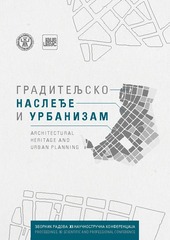Heritage Sites Vs. Construction Sites – Belgrade’s Ušće
Конференцијски прилог (Објављена верзија)
Метаподаци
Приказ свих података о документуАпстракт
The paper explores sensitive relation between built heritage and modernisation in the urban context. Heritage reflects the past, but it is now widely accepted to be inherently present-orientated and political, because decisions concerning which parts of the past should be protected and in what way, play a key role in how groups portray their peoples’ history, shared identity and collective memory to the outside world.
The focus of the analysis is on the area around the confluence of two international rivers – the Sava and the Danube – in Belgrade, locally called Ušće, which was a strategic point for the city’s birth and development on the account of its topographical and natural features. Once again in Belgrade’s history, this area is in the centre of attention, this time as the main location of the ongoing process of Belgrade`s radical urban change/development.
Impossible to separate from heritage, the term landscape will be explored in the context of Ušće, as it refers to a compl...ex and fluid concept, which perfectly depicts the relation between physical environment and cultural and social meanings of a certain place. Hence, the tools and processes of identification, conservation and management of both extraordinary heritage and ordinary landscape are growing ever closer (Council of Europe, 2000).
Кључне речи:
Belgrade / Confluence of rivers / Heritage / Landscape / ModernisationИзвор:
Zbornik radova: XI naučnostručna konferencija, 2021, 465-474Издавач:
- Zavod za zaštitu spomenika kulture grada Beograda
Финансирање / пројекти:
- Министарство науке, технолошког развоја и иновација Републике Србије, институционално финансирање - 200025 (Универзитет у Београду, Институт за филозофију и друштвену теорију) (RS-MESTD-inst-2020-200025)
Колекције
Институција/група
IFDTTY - CONF AU - Iguman, Sanja PY - 2021 UR - http://rifdt.instifdt.bg.ac.rs/123456789/2255 AB - The paper explores sensitive relation between built heritage and modernisation in the urban context. Heritage reflects the past, but it is now widely accepted to be inherently present-orientated and political, because decisions concerning which parts of the past should be protected and in what way, play a key role in how groups portray their peoples’ history, shared identity and collective memory to the outside world. The focus of the analysis is on the area around the confluence of two international rivers – the Sava and the Danube – in Belgrade, locally called Ušće, which was a strategic point for the city’s birth and development on the account of its topographical and natural features. Once again in Belgrade’s history, this area is in the centre of attention, this time as the main location of the ongoing process of Belgrade`s radical urban change/development. Impossible to separate from heritage, the term landscape will be explored in the context of Ušće, as it refers to a complex and fluid concept, which perfectly depicts the relation between physical environment and cultural and social meanings of a certain place. Hence, the tools and processes of identification, conservation and management of both extraordinary heritage and ordinary landscape are growing ever closer (Council of Europe, 2000). PB - Zavod za zaštitu spomenika kulture grada Beograda C3 - Zbornik radova: XI naučnostručna konferencija T1 - Heritage Sites Vs. Construction Sites – Belgrade’s Ušće SP - 465 EP - 474 UR - https://hdl.handle.net/21.15107/rcub_rifdt_2255 ER -
@conference{
author = "Iguman, Sanja",
year = "2021",
abstract = "The paper explores sensitive relation between built heritage and modernisation in the urban context. Heritage reflects the past, but it is now widely accepted to be inherently present-orientated and political, because decisions concerning which parts of the past should be protected and in what way, play a key role in how groups portray their peoples’ history, shared identity and collective memory to the outside world.
The focus of the analysis is on the area around the confluence of two international rivers – the Sava and the Danube – in Belgrade, locally called Ušće, which was a strategic point for the city’s birth and development on the account of its topographical and natural features. Once again in Belgrade’s history, this area is in the centre of attention, this time as the main location of the ongoing process of Belgrade`s radical urban change/development.
Impossible to separate from heritage, the term landscape will be explored in the context of Ušće, as it refers to a complex and fluid concept, which perfectly depicts the relation between physical environment and cultural and social meanings of a certain place. Hence, the tools and processes of identification, conservation and management of both extraordinary heritage and ordinary landscape are growing ever closer (Council of Europe, 2000).",
publisher = "Zavod za zaštitu spomenika kulture grada Beograda",
journal = "Zbornik radova: XI naučnostručna konferencija",
title = "Heritage Sites Vs. Construction Sites – Belgrade’s Ušće",
pages = "465-474",
url = "https://hdl.handle.net/21.15107/rcub_rifdt_2255"
}
Iguman, S.. (2021). Heritage Sites Vs. Construction Sites – Belgrade’s Ušće. in Zbornik radova: XI naučnostručna konferencija Zavod za zaštitu spomenika kulture grada Beograda., 465-474. https://hdl.handle.net/21.15107/rcub_rifdt_2255
Iguman S. Heritage Sites Vs. Construction Sites – Belgrade’s Ušće. in Zbornik radova: XI naučnostručna konferencija. 2021;:465-474. https://hdl.handle.net/21.15107/rcub_rifdt_2255 .
Iguman, Sanja, "Heritage Sites Vs. Construction Sites – Belgrade’s Ušće" in Zbornik radova: XI naučnostručna konferencija (2021):465-474, https://hdl.handle.net/21.15107/rcub_rifdt_2255 .



